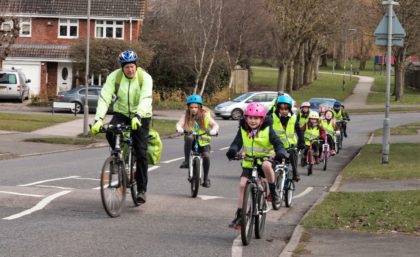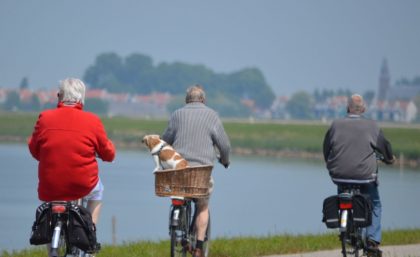Cycling needs to be encouraged because it’s green, healthy and fun and it helps children to become independent. However, it is important for young children to learn how to stay safe on a bicycle from the start: in 2010, 168 child cyclists aged 0-11 were killed or seriously injured on Britain’s roads.
Helping your child stay safe
- Find out if cycle training for your child is available in your area.
- Check your child’s bike to see if it’s roadworthy: look at brakes, tyres and lights / reflectors (when riding at dusk or at night you must have a white front light and a red back light and rear reflector, and it’s a good idea to fit spoke reflectors too).
- Make sure the bike is the right size for your child.
- Find out where local cycle paths and lanes are.
- Make sure your child has a helmet which fits and is worn correctly (it should not be pushed too far back on the head). Helmets must be properly fastened so they don’t come off in a collision.
- Ensure your child wears high-visibility clothing when cycling.
- When out and about with your child look at cyclists and talk about how easy they are to see.
Child seats
For use with one child from around six months up to five years
When a baby can support its own head (usually 6 – 12 months) they can be carried in a child seat. Seats are fitted mainly to the rear of the bike.
Trailers
For use with up to two children aged from babies up to five years. Trailers are a good choice for those wishing to travel with more than one child on a bike ride even of different ages. Babies can be strapped into their car seat and carried in a trailer whilst older children can be strapped in and protected from the wind and rain.
Tag-along trailer bikes
For use with one child from 4 years up to 9 years
A Tag-along is the back half of a child’s bike which is attached to the back of an adult’s bike which allows your child to be towed. Similar to a tandem bike, it gives your child the opportunity to pedal or freewheel as they wish and enjoy the ride. You can attach a tag along to any bike including tandems.
Top Tips
In order to make the journey much more comfortable and therefore enjoyable for your child, good foot support and padding will protect them from any bumps.
Straps and padded headrests are essential because children will sometimes fall asleep on a ride. For an economical buy, choose a seat that can grow with your child and is compatible with panniers.
Tow bar
For children from 4 to 8 years.
A tow bar converts a standard child’s bike to a trailer bike by lifting their front wheel from the ground to prevent them from steering, while enabling them to pedal independently. When you reach a safe place, the tow bar can be detached and the bike released.
How to teach your child to ride a bike
There are many options available to teach your child how to cycle and to build up their confidence before setting out on their own.
Tricycles
For children from 10 months to 5 years
These have balance and stability. They also have pedals so they can get used to pedalling whilst having the stability they need to practice.
Balance bikes are like normal bikes but without the pedals. This means children learn to balance, steer and gain confidence on two wheels while being able to place their feet firmly on the ground.
Stabilisers
These give support to the rear of the bike and are the easiest way to learn to ride a bike as they keep it more stable than just having 2 wheels. Children can learn how to pedal and brake without having to master the balance of the bike at the same time but this can be the slowest way to learn. Stabilisers can then be gradually lifted off the ground to provide less and less support so the child develops their balance.
Bikes with stabilisers should lean a little.
If the bike doesn’t lean, the rear wheel isn’t on the ground and the brakes will be ineffective.

